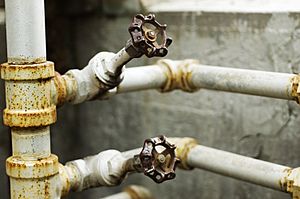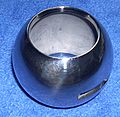Valve facts for kids
A valve is a special device that helps control the flow of liquids, gases, or even tiny solids mixed in a fluid. Imagine it like a tap on a sink, but for big pipes or machines! Valves can start, stop, or change how much of something flows through a pipe or into a container. They are super important in many places, from your home's plumbing to huge factories.
Contents
How Valves Work
Valves work by having a part that moves to block or open a pathway. When the pathway is open, the fluid can flow through. When it's closed, the flow stops. By partly closing the pathway, you can control how much fluid goes through, making the flow faster or slower. This simple idea helps us manage water, gas, and many other things safely and efficiently.
Types of Valves
There are many different kinds of valves, each designed for a specific job. Here are a few common types:
- Globe valve: These valves are good for controlling the flow rate precisely. They have a movable disc that moves up and down to block the flow.
- Gate valve: Gate valves are like a gate that slides up or down. They are best for fully opening or fully closing a pipe, not for controlling the flow amount.
- Butterfly valve: This valve has a disc that rotates, like a butterfly's wing. It's often used for large pipes and can quickly open or close the flow.
- Safety valve: These are very important for safety! They automatically open to release pressure if it gets too high in a system, preventing damage or accidents.
Where Are Valves Used?
Valves are everywhere! You might not even notice them, but they play a huge role in our daily lives.
- In your home: Taps, shower controls, and toilet flush mechanisms all use valves.
- Water systems: Valves control the water that comes to your house and the wastewater that leaves.
- Factories and industries: They are essential in power plants, chemical factories, and oil refineries to manage different fluids.
- Vehicles: Cars, planes, and ships use valves in their engines and fuel systems.
Controlling Valves
Valves can be controlled in different ways:
- Manually: Many valves are operated by hand. You might turn a wheel, pull a lever, or push a button to open or close them.
- Automatically: Some valves work on their own. They might use electricity, air pressure, or even the pressure of the fluid itself to open or close. This is common in complex systems where quick or precise control is needed without human help.
Images for kids
-
Inconel X750 spring
-
A seacock for cooling seawater, on a marine diesel engine. Seacocks are usually ball valves, but may be other types as well.
-
A valve controlled by a wheel (on vertical line)
-
Hastelloy ball valve
-
Duplex ball valve
-
Stainless steel ball valve
-
Duplex ball valves
-
Super duplex ball valves
-
Balls for alloy ball valves
-
Ball for a titanium ball valve
Related Pages
See also
 In Spanish: Válvula para niños
In Spanish: Válvula para niños





























